Top Scenario Modeling Software for Startups: Features and Comparisons
July 30, 2025
Owen Bitas
Top Scenario Modeling Software for Startups: Features and Comparisons
Finance leaders often scramble to understand how ownership will shift when a fundraising event lands on the cap table. Yet many still rely on static spreadsheets to model these changes. Without context for how ownership evolves round to round, they’re forced to make critical decisions with incomplete information.
Small modeling errors, such as underestimating how a SAFE converts, can disrupt hiring plans or result in employees, founders, or investors having less equity than expected. Scenario modeling software enables finance leaders to forecast how the cap table will shift before finalizing decisions. But to be useful, it must reflect the company’s equity data and structure, not a simplified version built in isolation.
To help you compare scenario analysis software, we’ll go beyond templates. You’ll see which platforms are equipped to simulate complex rounds and which fall short. We’ll also show you how Pulley lets you explore multiple scenarios and optimize ownership allocation in real time, before anything is finalized.
What is scenario modeling software?
Founders and CFOs can get a clearer view of how ownership evolves under different funding structures with accurate scenario planning. That could include a new funding round, an equity grant, or a change in valuation. Scenario modeling software should reflect your cap table’s actual structure, enabling your finance team to test outcomes before making any changes.
The best platforms handle items like SAFEs, convertible notes, dilution events, and refresh grants without more spreadsheets. They help decision-makers understand how ownership shifts and which outcomes carry the most impact. The right scenario modeling software connects to your equity data, allowing you to evaluate trade-offs before they impact control or future terms.
Why spreadsheets break down
Spreadsheets are often the first tool used to model a cap table because they’re accessible and easy to customize. But as your company grows, that flexibility can become a liability. Manually updating ownership after each round or grant opens the door to potential future errors that can add up fast.
"Since they’re not connected to live data, spreadsheets can’t dynamically show how SAFEs convert, how refresh grants affect dilution, or how new rounds impact existing stakeholders. As your business grows more complex, it becomes harder to trust the numbers. Connecting your model to real-time data provides a clearer view of trade-offs before they hit your cap table, so you can make informed decisions.
If you’ve ever tried to map out dilution in a spreadsheet, you know how quickly things get complicated. Pulley’s guide to modeling dilution breaks down how these dynamics play out and why accurate scenario planning matters.
How modern tools help finance leaders scale
Modern scenario planning software addresses these gaps by connecting directly to your cap table and valuation data. With live inputs in place, simulations reflect your current ownership structure in real time.
Finance leaders can streamline their workflow to quickly explore funding outcomes and share investor-ready metrics. Instead of building one-off financial models, finance leaders gain a repeatable system that brings clarity to high-stakes equity decisions.
Key features to look for in scenario modeling software
Not all scenario modeling software can handle the complexity involved in startup equity planning. Many focus on general forecasting without accurately modeling your specific equity structure.
Look for features that tie equity planning to the actual impact on ownership, including:
- Real-time cap table integration: Tools that sync with your live cap table reduce guesswork by pulling in real ownership data and reflecting the equity already in play.
- Support for SAFEs, convertible notes, and option pool resizing: Your tool should be able to handle pre- and post-money SAFEs, notes with discounts or caps, and option pool adjustments before or after the round.
- Side-by-side scenario comparisons: Seeing different round structures side by side helps founders and CFOs align on trade-offs early, before committing.
- Built-in modeling for dilution, valuations, and employee equity: Robust platforms go beyond simple inputs; they reveal how dilution plays out over time and how employee equity value evolves as your company grows.
- Exportable reports for board and investors: Your modeling tool should produce clean, export-ready outputs that support board discussions and investor updates without requiring additional formatting.
ASC 718 and 409A visibility: Forecasting tools with built-in visualization reveal how equity decisions affect expense recognition and valuations, reducing surprises during due diligence. Tied into your scenario planning process, they help model how pricing changes or new grants impact dilution.
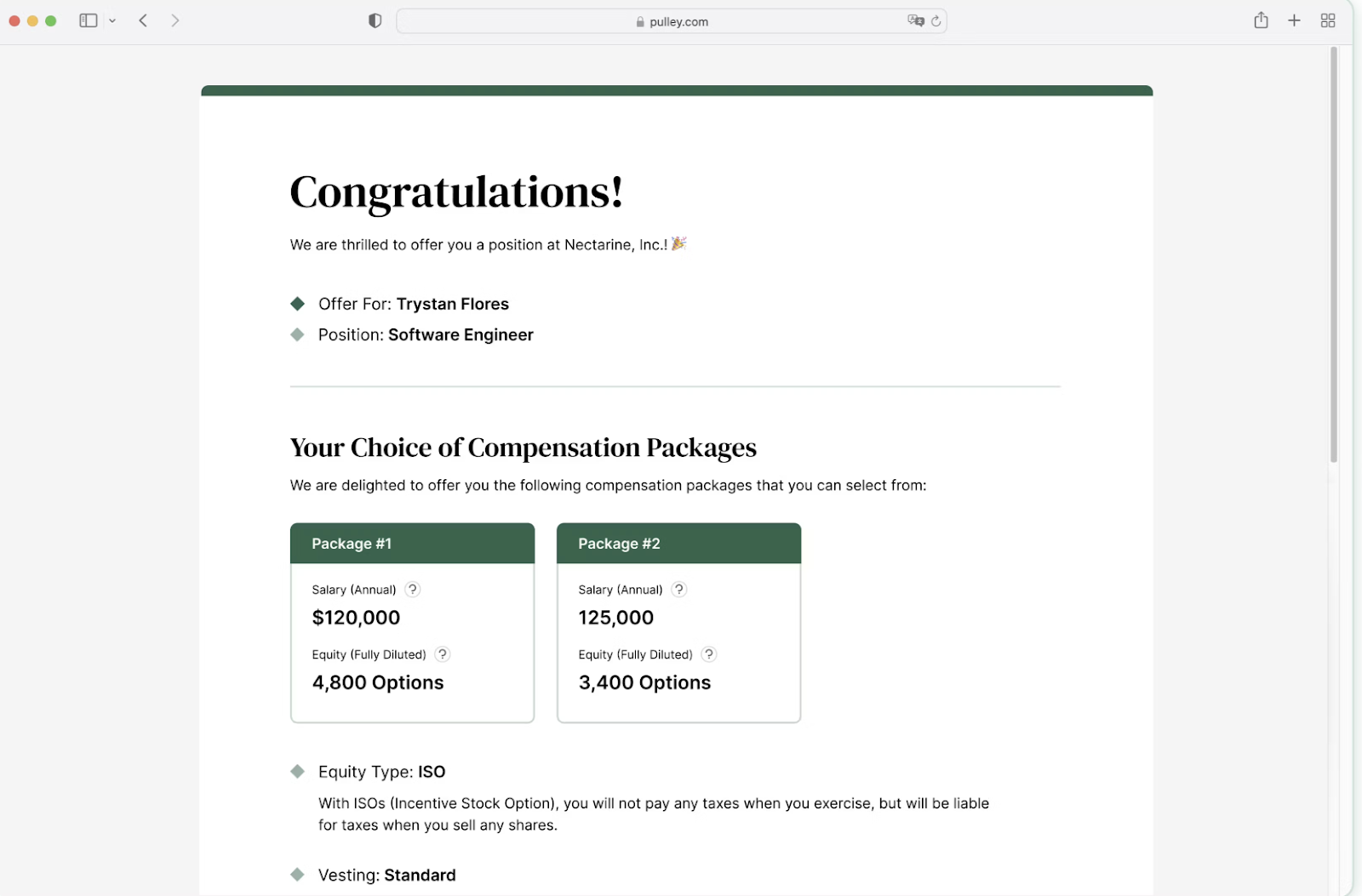
Pulley’s scenario modeling view of employee compensation options (Source: Pulley)
The right feature set simplifies modeling and supports more confident decision-making for founders. Before committing to a tool, make sure it accurately reflects your current equity structure and updates automatically as ownership changes. Your data stays in sync as changes occur, and you won’t be relying on outdated inputs.
The best scenario modeling software for startups (ranked by use case)
Choosing the right scenario modeling software depends on how closely it aligns with your startup’s equity decisions-making process. Some platforms support broader financial planning, while others specialize in cap table modeling and ownership forecasting.
We’ve ranked these tools based on the startup scenarios where they perform best, from all-in-one equity planning to investor-mandated platforms and lightweight financial modeling. For a broader view of equity platforms, Pulley’s cap table management software guide offers a helpful breakdown.
Pulley: Best for most startups and growing companies
Pulley’s software solution for scenario modeling integrates directly with its cap table, 409A, and ASC 718 tools, so every simulation reflects live equity data. Founders and finance leaders can model SAFEs, pro-rata rights, and option pool changes in real time, then compare different scenarios visually and export reports built for board or investor review.
If you need a refresher before modeling, Pulley’s Equity Terms Guide breaks down key terms, enabling decision-makers to model confidently.
Pulley also supports the more complex modeling needs of growth-stage companies, such as managing multiple rounds, modeling secondary sales, or preparing for audits and due diligence. It also helps finance leaders move fast and stay aligned on ownership and compliance at every stage of growth.
Pros:
- All-in-one solution for scenario modeling, cap table management, 409A, and ASC 718
- Live equity data integrated directly into every simulation
- Intuitive interface for both founders and finance teams
- Built to scale from early-stage through later fundraising rounds
Cons:
- Less known among investors who default to Carta (despite more modeling functionality)
- May involve switching platforms if a startup begins on another cap table tool
See Pulley’s scenario modeling software in action. Request a demo today.
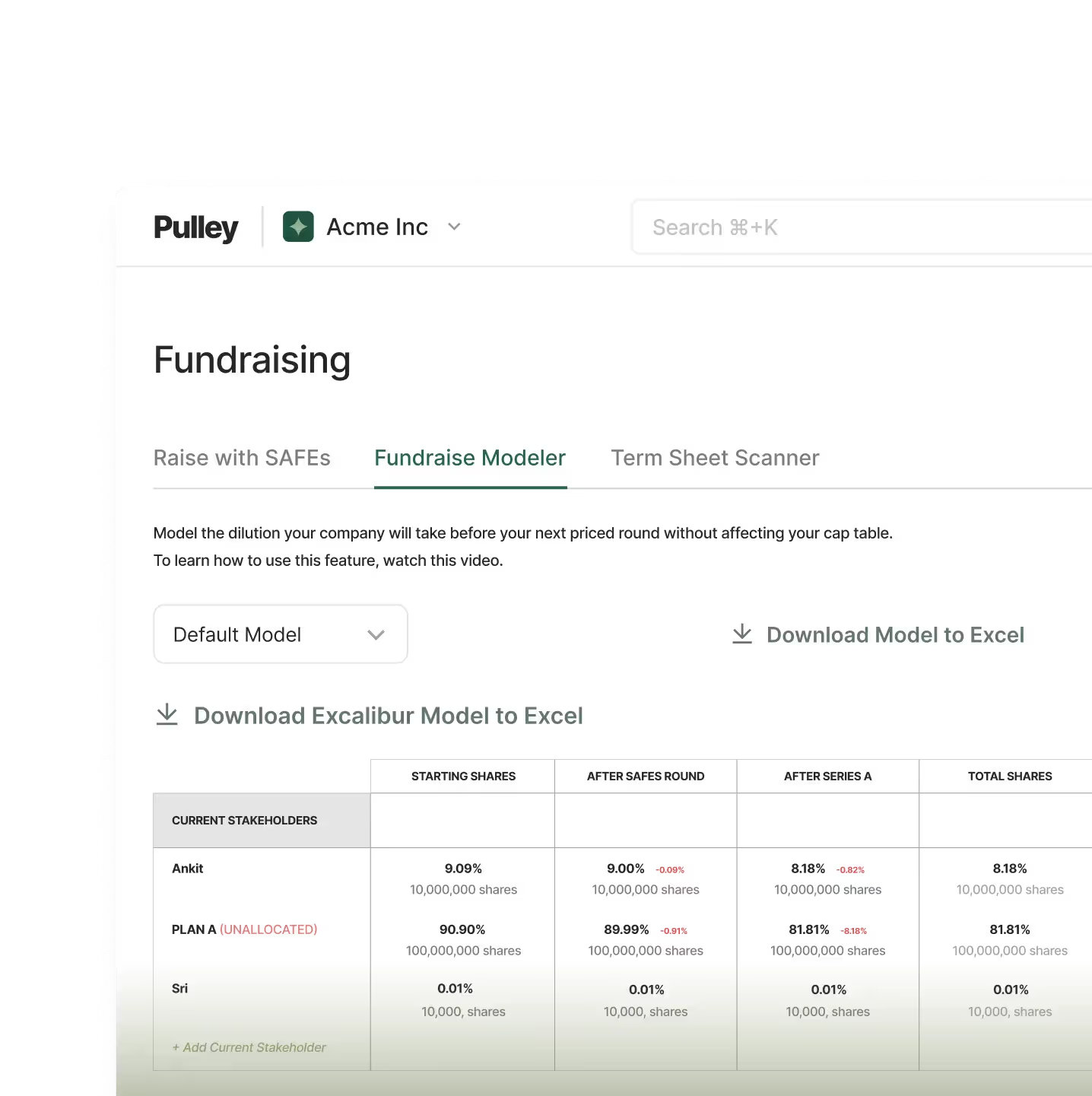
Carta: Best for companies already embedded in the platform
Carta offers modeling capabilities for higher-tier customers, but many inputs still require manual updates, which can introduce complexity. Valuations are handled separately, which limits visibility into their impact on ownership outcomes.
For companies already embedded in Carta’s platform, the modeling tools can be serviceable. But for startups looking to connect scenario planning with live equity data, integration remains limited. Most equity data must be entered manually instead of syncing automatically.
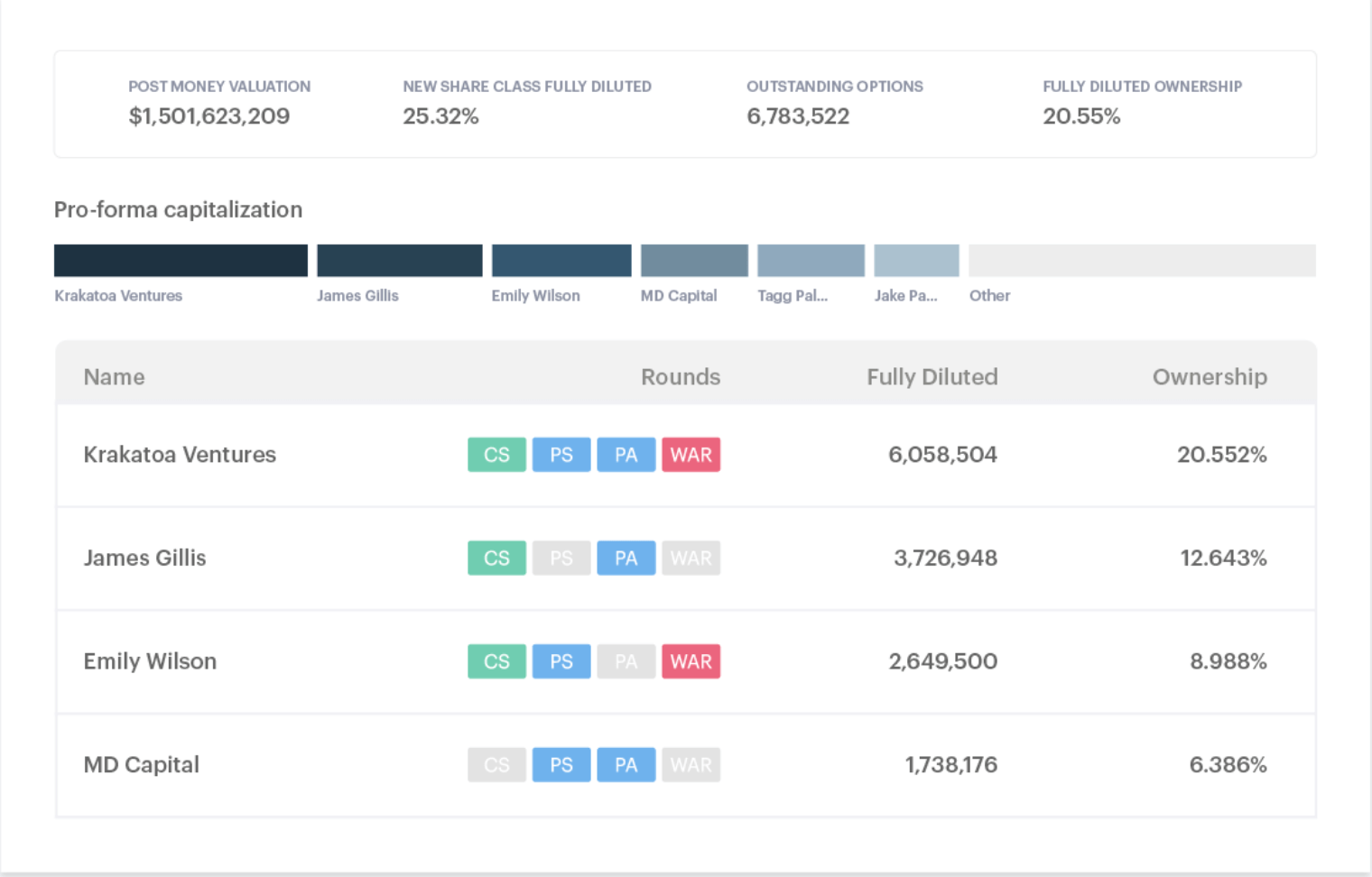
Carta’s waterfall modeling tool example (Source: Carta)
Pros:
- It’s widely used by startups and offers basic cap table management features.
- For companies already using the platform, its modeling tools add some convenience without requiring a full switch.
Cons:
- Modeling features are only available on higher-tier plans, and many inputs must still be added manually.
- Since Carta manages valuations separately, users find it harder to see how funding terms affect ownership in real time.
LTSE Equity: Best for early-stage teams with simple equity needs
LTSE Equity is clean and easy to navigate, making it particularly suitable for early-stage founders. It works well for tracking ownership at a high level, but lacks the modeling depth needed for complex fundraising scenarios.
For example, LTSE offers no support for ASC 718 visibility, making it harder to forecast the expense impact of equity grants.
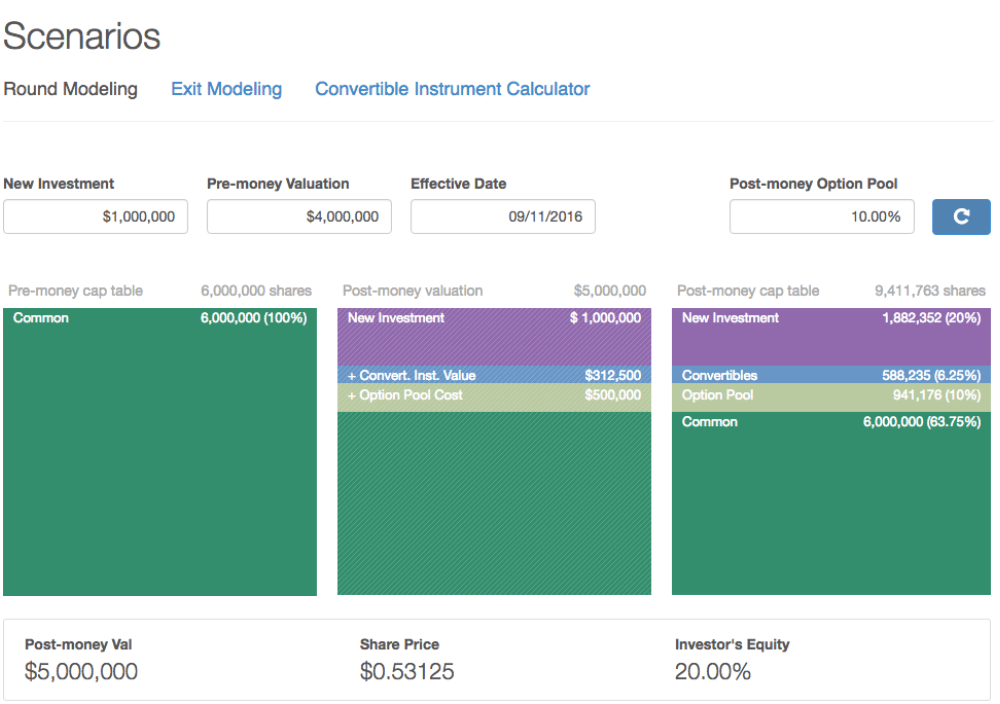
LTSE Equity’s round modeling example (Source: LTSE Equity)
Pros:
- Its intuitive interface makes it easy for early-stage founders to get up and running quickly.
- It’s a good fit for tracking ownership at a basic level, with a relatively low learning curve.
Cons:
- It lacks support for more advanced modeling scenarios, such as secondary sales or SAFEs with custom terms.
- It offers no ASC 718 visibility, making it difficult to forecast equity-related expenses during fundraising or hiring.
Forecastr: Best for those that don't need equity planning support
Forecastr excels in financial forecasting, particularly in cash flow and revenue projections. But because it doesn’t tie into your cap table, equity modeling remains a manual process. Unlike Pulley, startups typically pair Forecastr with a second tool such as Carta or Cake to handle cap table and dilution modeling. The result is a more complex and costly planning stack.
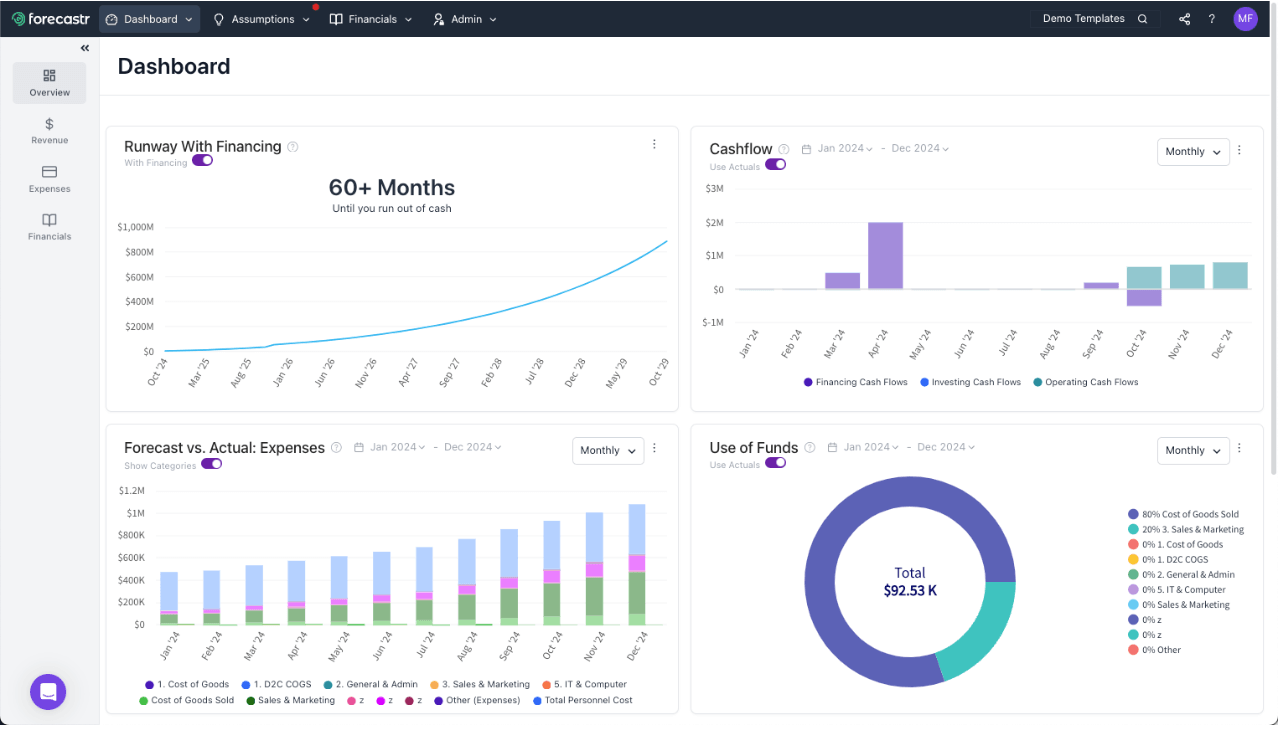
Forecast’s financial model dashboard example
(Source: Forcastr)
Pros:
- It excels in financial planning, making it easy to model burn and runway.
- It’s especially helpful for founders focused on cash management and top-line forecasting.
Cons:
- It doesn’t connect to your cap table, requiring manual equity modeling.
- Most companies end up pairing it with a separate platform to gain a full picture of ownership and dilution.
FlowCog / Pry / Finmark (honorable mentions)
These tools focus on budgeting, ARR, and burn tracking.
While useful for finance-stack visibility, they aren’t designed for equity modeling or fundraising simulations. They may suit CFOs looking to round out a broader financial planning toolkit, but they don’t incorporate detailed cap table data or equity mechanics.
Without access to the actual cap table, scenario modeling remains shallow. These tools can estimate dilution, but they can’t connect it to real ownership stakes, pro-rata rights, or option pool dynamics.
Why Pulley leads for fundraising scenario modeling
Fundraising impacts every part of the cap table, but many tools treat it as a basic modeling exercise with limited visibility into ownership details. Pulley takes a more comprehensive approach.
Scenario modeling is integrated directly into the equity platform, so every simulation reflects live ownership, grant schedules, and 409A valuation data. This full integration eliminates manual imports and lets you start modeling right away.
Pulley’s fundraising modeling simulates SAFEs, pro-rata rights, and option pool adjustments in detail. You can preview pro forma ownership for each participant, see how different terms affect dilution, and generate outputs that are ready for investor decks.
Since the software pulls from your real cap table, you can run different scenarios without versioning errors or last-minute cleanups.
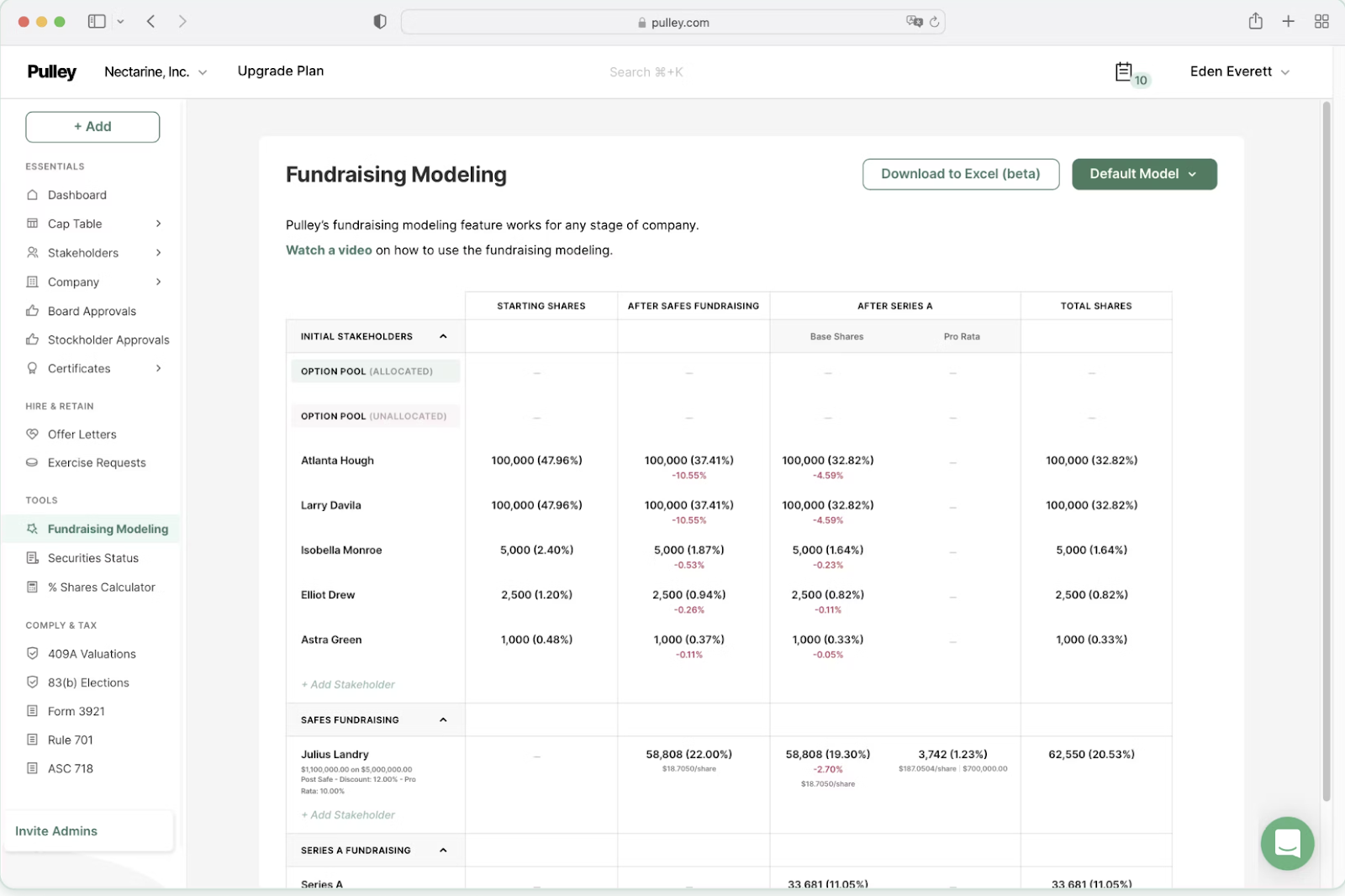
How each fundraising round affects stakeholder ownership in real terms with Pulley (Source: Pulley)
Scenario modeling gives users an edge when preparing for a round or negotiating terms. Pulley helps finance leaders move quickly by showing how each decision affects ownership now and in possible future rounds.
For growth-stage startups, real-time data and audit-ready reports make it easier to get through diligence without last-minute cleanup. That kind of clarity also keeps growth on track for companies scaling quickly.
Pick the right software solution for your startup stage
Selecting the right scenario modeling software depends on what you need to plan. Early-stage teams focused on cash flow may find that tools like Forecastr or Pry cover the basics. Once ownership considerations start impacting decisions, however, your scenario modeling software must be able to accurately reflect your cap table.
General-purpose tools often fall short. They can’t simulate how SAFEs convert or how an option pool shift affects founder ownership. Without a connection to actual equity data, it’s easy to make decisions that unravel later.
High-stakes equity decisions leave no room for guesswork. Book a demo to see how Pulley models real outcomes using your actual cap table.
Scenario modeling FAQs
What is scenario modeling software used for in startups?
Scenario modeling software provides startups the visualization they need to see how decisions like fundraising or hiring will impact ownership before anything is finalized.
How does Pulley’s scenario modeling differ from Carta or Excel?
Pulley connects to your live cap table and valuations, so you can model complex rounds without manual updates or hidden errors. Unlike Excel, which relies on static data and fragile formulas, Pulley keeps everything current automatically.
Do I need scenario modeling software if I already use Forecastr or Finmark?
Forecastr and Finmark are built for cash planning, not equity modeling. If you’re raising capital or issuing equity, you’ll need a tool that ties directly to your cap table.
Can I use scenario modeling for employee equity planning?
Yes. Pulley’s offer letter tool reveals how equity value changes in relation to future valuations, providing workforce planning teams with a realistic view of total compensation.
Is Pulley’s scenario modeling included with the cap table platform?
Yes, Pulley’s scenario modeling is built in, so equity planning and fundraising stay in one place.
Switch to Pulley
Pulley simplifies equity management - Cap tables, 409a valuations, SBC reporting, scenario modeling, SAFEs, RSUs, options, and more.
By subscribing you agree to our Privacy Policy.